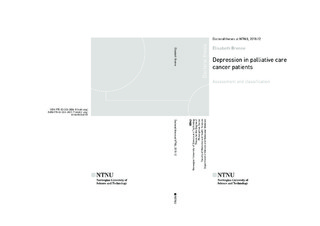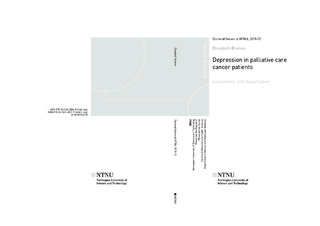| dc.contributor.advisor | Kaasa, Stein | |
| dc.contributor.advisor | Wasteson, Elisabet | |
| dc.contributor.advisor | Loge, Jon Håvard | |
| dc.contributor.author | Brenne, Elisabeth | |
| dc.date.accessioned | 2018-03-02T14:30:26Z | |
| dc.date.available | 2018-03-02T14:30:26Z | |
| dc.date.issued | 2018 | |
| dc.identifier.isbn | 978-82-326-2837-7 | |
| dc.identifier.issn | 1503-8181 | |
| dc.identifier.uri | http://hdl.handle.net/11250/2488393 | |
| dc.description.abstract | Palliative care aims at improving quality of life and reducing suffering in patients with lifethreatening illness through the early identification, assessment and treatment of problems. Depression reduces quality of life in patients with advanced cancer, and depression can be treated. Common international classification and assessment of symptoms are developed to provide optimal and equal intervention. The aim of the research project European Palliative Care Research Collaborative (EPCRC) (2006-2010) was to contribute to international development of assessment and classification of the symptoms pain, cachexia and depression. The aim of this thesis is to contribute to the development of classification and assessment of depression in palliative care cancer patients.
Development of classification and assessment of psychological symptoms should be initiated by systematic literature reviews. The reviews should clarify current evidence and practice and should also justify and guide the further research process. A systematic literature review was conducted to explore how depression has been assessed and classified in palliative care research. In 202 publications reporting on clinical studies, 106 different assessment methods of depression were identified; 65 of the methods were applied only once. There were major geographical differences in terms of amount of publications and assessment methods used. Classification (defining cases of depression) was conducted in 59% of the assessment reports (200 of 337). When classification was conducted, cut-offs on scores were used in 76% (147 of 200) and diagnoses according to psychiatric classification in 24% (47 of 200). The huge variation in ways of assessing depression creates uncertainty in the evaluation of depression in the clinics and hampers comparisons of studies. Palliative care is clearly in need of developing common classification and assessment of psychological symptoms.
According to international standards, conceptualisation is an initial step in the development of classification and assessment of symptoms. In-depth interviews of individuals from the relevant population should be included in the research process. To explore patients´ experiences of depression, an interview study was conducted. Thirty in-depth interviews describing major depression in patients with advanced cancer were analysed according to the phenomenographic method.
Symptoms with clear content were: Lowered mood, Diminished motivational drive, Despair, Anxiety, Relentless focus on the situation and Social withdrawal
Symptoms with mixed content (depressive content mixed with other content) were:
Restlessness, Disrupted sleep, Appetite and weight changes, Feeling of worthlessness, Feeling of guilt and Thought of death as a solution.
Compared to depressive symptoms in psychiatric classification, Anxiety, Despair, Social withdrawal and Relentless focus on the situation appeared as supplementing symptoms.
One way of screening depression is by a single item assessment. The Edmonton Symptom Assessment System (ESAS) is a widely used instrument that measures symptoms in patients with cancer. The ESAS includes one item on depression (ESAS-Depression). The patients score depression on a numerical scale from zero to ten. How to interpret ESAS scorings is not documented. Study 3 aimed to study the criterion validity of ESAS-Depression compared to Major Depressive Episode (MDE) according to the psychiatric classification system DSM-5 and assessed by the Patient Health Questionnaire (PHQ-9). The study is an international cross-sectional study (n=969). ESAS-Depression had limited criterion validity towards MDE assessed by PHQ-9. The results reflect high uncertainty in the interpretation of ESAS as a screener for MDE assessed by the PHQ-9. | nb_NO |
| dc.language.iso | eng | nb_NO |
| dc.publisher | NTNU | nb_NO |
| dc.relation.ispartofseries | Doctoral theses at NTNU;2018:12 | |
| dc.relation.haspart | Paper 1:
Wasteson, Elisabet; Brenne, Elisabeth; Higginson, I; Hotopf, M; Lloyd Williams, M; Kaasa, Stein; Loge, Jon Håvard.
Depression assessment and classification in palliative cancer patients: a systematic literature review. Palliative Medicine : A Multiprofessional Journal 2009 ;Volum 23.(8) s. 739-753
https://doi.org/10.1177/0269216309106978 | |
| dc.relation.haspart | Paper 2:
Brenne, Elisabeth; Loge, Jon Håvard; Kaasa, Stein; Heitzer, Ellen; Knudsen, Anne Kari; Wasteson, Elisabeth.
Depressed patients with incurable cancer: Which depressive symptoms do they experience?. Palliative & Supportive Care 2013 ;Volum 11.(6) s. 491-501
Is not included due to copyright available at
https://doi.org/10.1017/S1478951512000909 | |
| dc.relation.haspart | Paper 3:
Brenne, Elisabeth; Loge, Jon Håvard; Lie, Hanne Cathrine; Hjermstad, Marianne Jensen; Fayers, Peter; Kaasa, Stein.
The Edmonton Symptom Assessment System: Poor performance as a screener for major depression in patients with incurable cancer. Palliative Medicine 2016 ;Volum 30.(6) s. 587-598
https://doi.org/10.1177/0269216315620082 | |
| dc.title | Depression in palliative care cancer patients - Assessment and classification | nb_NO |
| dc.type | Doctoral thesis | nb_NO |
| dc.subject.nsi | VDP::Medisinske Fag: 700::Klinisk medisinske fag: 750 | nb_NO |

